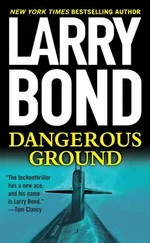The color display was designed to show detailed bathymetric sonar data, not a high-resolution photographic image. Palmer had selected a false-color mode that showed a strong sonar return as a brighter color than a softer echo. Thus, rocks on the seabed showed as yellow against a mottled brown and purple bottom, probably sand and mud. The false colors only threw off an observer for a moment. The UUVs primary sensors used high frequency sonars along with a precision underwater mapping algorithm, which gave the image the sharpness of a television camera. The observers could see patterns on the seabed where currents had scoured the bottom, a few clusters of rocks, but nothing more.
Rudel ordered, “Shift back to the long-range search.”
Palmer hit a key and a few seconds later the image shrank into the foreground as the sonar shifted range scales. Ahead and slightly to the left, near the top of the screen, a yellow-green shape appeared. “Range is six hundred fifty yards,” Palmer reported.
“Take your time,” Shimko cautioned, needlessly. The display showed LaVerne at a speed of three knots. She couldn’t go any slower and still be steered reliably.
It had to be Severodvinsk. It was in the right place, and after a day and a half of searching they were running out of places to look. The system had reported an anomalous contact at a range of over eight hundred yards, about half of maximum range for the vehicle’s sonar. An indistinct echo at that range, and in multiple sonar beams had to be something big, maybe a sunken submarine or a large outcropping of rocks.
The closer the UUV got, the more the blip took on a recognizable shape. Jerry studied it, along with everyone else in the room. He was looking for something that would show it wasn’t the sub as much as something that said it was. They’d had several false alarms in the past twenty-four hours, and he’d been delayed in the control room checking the updated charts for wrecks. There were none recorded by any of the UUVs in the area — a good sign. But this was no false alarm. It was just too big.
“It’s the right size,” Shimko observed cautiously.
“Could be, XO, but shouldn’t we have seen it further out than eight hundred yards?” asked Lavoie.
“We’re probably dealing with a new type of anechoic coating on Severodvinsk. Maybe its high frequency performance is better than we thought,” replied Shawn McClelland.
“Two points for the sonar officer,” remarked Shimko without taking his eyes off the display screen.
After another few minutes, Palmer reported, “Range is five hundred yards.” The range readout was shown on the computer screen, but not everyone in the room could see the whole display.
The shape was definitely narrower at one end, which Jerry automatically labeled the stern. An irregular blob of canary yellow occupied a spot one-quarter of the way back from the other end. It was the proper location for Severodvinsk’s sail.
Rudel studied the readouts, then turned to the intercom. “Sonar, torpedo room. Do you have anything on bearing two four seven?”
“Torpedo room, sonar. We can hear LaVerne’s motor on the wide aperture array, bearing is two four six. Nothing else, sir.”
“Sonar, torpedo room, very well. Keep a special watch for anything from the southwest. LaVerne may have found the Russian.”
“Torpedo room, sonar, aye.”
Jerry shrugged. It would have been nice to have heard some sign of life, but couldn’t imagine what machinery could still be running aboard the downed sub. The object was quiet, inert.
“Hold at two hundred fifty yards and circle the contact.”
Palmer acknowledged Rudel’s order and typed in the commands. The “contact” now filled a quarter of the screen, and Jerry started to think of it as a sub. The perspective shifted and the shape resolved even more.
“It’s the Russian boat,” Shimko declared. “It’s Severodvinsk .” He turned to the torpedo room watchstander, wearing his sound-powered phones. “Tell control we’ve found the Russian. Log the time and location.”
An excited buzz broke out in the torpedo room, but Rudel and the other officers ignored it. Jerry noticed money changing hands in the back of the room.
“Tell me you’re recording this,” Shimko asked Palmer, and the junior officer nodded vigorously, his eyes still fixed on the display. “The instant we got a detection,” he answered, then pointed to a red “R” in one corner of the display.
The image’s outlines continued to shift as the aspect changed. The sail took shape at the appropriate spot along the hull, but foreshortened.
“She’s listing,” Palmer observed. “It’s bad.” Resting on the uneven bottom, the sub was tilted to port — a lot. The UUV continued its circle around toward the bow, looking down the length of the boat.
“I’d guess. what? Thirty degrees?” Shimko sounded as if he hated to be right.
“At least,” Rudel answered. “This is not good. With the deck at that angle, it’ll be really tough to dock a DSRV on an escape hatch. And they haven’t launched their rescue chamber, so if they’re alive, they’re trapped.”
LaVerne finished her circuit. The imaging sonar had given them a clear picture of the Russian, resting on a rocky shelf, down a few degrees by the bow and tilted drunkenly to port, like a child’s discarded toy. The shape of the sub matched what they knew of Severodvinsk.
“All right, let’s recall Maxine. She doesn’t have to search anymore. And get Patty ready for launch, just in case.” Shimko looked behind him. “And anyone who doesn’t have business in the torpedo room, back to your own spaces.”
The room cleared out quickly, but was soon filled with activity as the torpedo gang prepared to recover one UUV and readied another one for launch.
While they worked, at Rudel’s direction, Palmer steered LaVerne in a close pass down Severodvinsk’s length. This time, the sub’s bow filled the screen, and they could see dark patches, hollows in the curve of the bow. There were also several spots that had a ragged look to them. Dents where she’d struck? The bow planes looked small for such a large vessel, but stood out clearly.
LaVerne continued down the port side. The resolution was good enough to make out the limber holes in the hull, designed to let air escape from the ballast tanks when it submerged. Rudel had chosen the port side so that the deck would be tilted toward them. The sail loomed three stories above the hull, and Palmer started to back the UUV out to get a distance.
“No, stay in close,” ordered Rudel. “Look. There it is. The escape chamber is still in place. No masts extended, either.”
“They either didn’t have time to use the chamber or couldn’t use it,” Shimko answered.
“Hopefully, it’s ‘couldn’t use it,’” Rudel observed.
Stan Lavoie watched the image. “I’m not seeing any obvious breaks in the hull. Their sonar dome is crushed, but that’s made of GRP.”
“I agree,” said Rudel. “But the sonar image isn’t good enough to make an accurate call. Mr. Palmer, I want you to make another three-sixty pass once we’re done, and this time take digital pictures as you go. We can use them to get a better idea as to the damage.”
“Yessir,” responded Palmer.
Another minute passed as LaVerne moved further aft. Behind the sail, Severodvinsk’s hull was essentially a smooth cylinder. Except for the limber holes and small deck fittings that passed beneath them, it was hard to see the UUV’s motion. As the vehicle moved along the hull, a bright circular section appeared on the display.
“Look at that cavity!” exclaimed Lavoie. “Is that a hole in the hull?”
Читать дальше












